Related Research Articles

Neijia is the collective name for the internal Chinese martial arts. It relates to those martial arts occupied with spiritual, mental or qi-related aspects, as opposed to an "external" approach focused on physiological aspects. The distinction dates to the 17th century, but its modern application is due to publications by Sun Lutang, dating to the period of 1915 to 1928. Neijin is developed by using neigong or "internal changes", contrasted with waigong or "external exercises".

Tai chi is an ancient Chinese martial art. Initially developed for combat and self-defense, for most practitioners it has evolved into a sport and form of exercise. As an exercise, tai chi is performed as gentle, low-impact movement in which practitioners perform a series of deliberate, flowing motions while focusing on deep, slow breaths. Often referred to as "meditation in motion," tai chi aims to concentrate and balance the body's qi, providing benefits to mental and physical health.

Cheng Man-ch'ing or Zheng Manqing was a Chinese expert of tai chi, Chinese medicine, and the so-called three perfections: calligraphy, painting and poetry. He was born in Yongjia, Zhejiang Province, during the Qing dynasty. Cheng died March 26, 1975; his grave is near the city of Taipei in Taiwan.
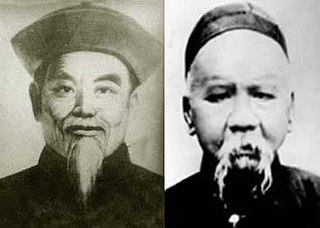
Wu (Hao)-style tai chi is one of the five primary styles of tai chi. It was created in the mid-nineteenth century by Wu Yuxiang, a member of a wealthy and influential family in Yongnian, Hebei, China. Wu trained for approximately ten years with the founder of Yang-style tai chi, and then for over a month with a Chen-style master. Wu also obtained a manual on internal martial arts that formed the core of what are now known as the tai chi classics and include Wu's own writing on the subject. From these sources Wu and his family developed their own style, and may also have developed much of the cultural and intellectual foundation of tai chi as well.

Yang-style tai chi is one of the five primary families of tai chi. Including its variations, it is the most popular and widely practised style of tai chi in the world today. It is second in terms of seniority, after Chen-style tai chi.
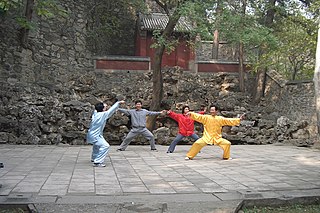
The Chen-style tai chi is a Northern Chinese martial art and the original form of tai chi. Chen-style is characterized by silk reeling, alternating fast and slow motions, and bursts of power.
Neigong, also spelled nei kung, neigung, or nae gong, refers to a series of internal changes that a practitioner goes through when following the path to Dao, and these changes may be achieved through practices including qigong or tai chi. Neigong is also associated with xingyi quan.

Huaquan is a Chinese martial art in the changquan family. It is believed to have originated during the Liu Song dynasty near Mount Hua in Shaanxi Province.
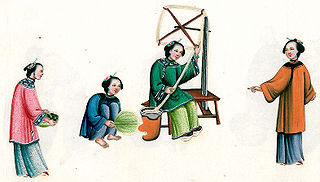
Silk reeling refers to a set of neigong movement principles expressed in traditional styles of tai chi (太極拳), but especially emphasized by the Chen and Wu styles.
Wong Kiew-kit is a grandmaster in the tradition of the mythical Southern Shaolin Monastery in China, which should not be confused with the more commonly known Shaolin Monastery in Henan Province. Wong founded the Shaolin Wahnam Institute in 1982 in order to teach Shaolin arts to the public. Master Wong practiced and learned within a number of famous lineages which place him as a fourth generation successor of the Ven. Jiang Nan and a sixth generation successor of the Ven. Chee Seen both of the Southern Shaolin Temple.
Stephan Berwick is an American author, martial artist, and actor known for his scholarly research on traditional Chinese martial arts – particularly Chen-style taijiquan, and roles in early Yuen Wo-ping Hong Kong Action films.

Sam Masich is a tai chi instructor, performing songwriter and filmmaker residing in Vancouver, British Columbia, Canada and Berlin, Germany.
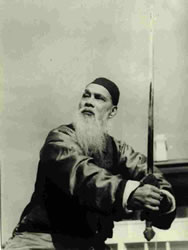
Wang Ziping was a Chinese Muslim practitioner of Chinese Martial Arts and traditional medicine from Cangzhou, Cangxian county, Mengcun, Hebei Province. He served as the leader of the Shaolin kung fu division of the Martial Arts Institute in 1928 and was also the vice chairman of the Chinese Wushu Association. Wang was known for his mastery of Chaquan, Huaquan, Leopard kung fu, Bajiquan, and tai chi. He was also a master of Wushu.
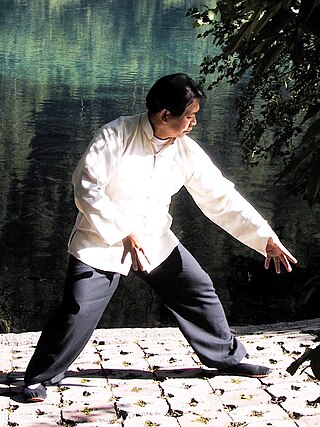
Qigong is a system of coordinated body-posture and movement, breathing, and meditation said to be useful for the purposes of health, spirituality, and martial arts training. With roots in Chinese medicine, philosophy, and martial arts, qigong is traditionally viewed by the Chinese and throughout Asia as a practice to cultivate and balance the mystical life-force qi.

Doc-Fai Wong is a master of tai chi and the Hung Sing branch of Choy Li Fut kung fu. He was born in 1948 in the Guangdong province of China, specifically, the Wangshan village in the Doumen District of Zhuhai. In April 1960, he and his mother immigrated to San Francisco, California to be reunited with his father. He arrived as a third-generation citizen of the United States of America since both his grandfather and father were already citizens. He sought out his first kung fu teacher - Lau Bun (劉彬), the founder of the first Hung Sing Kwoon of Choy Li Fut in America, after encountering taunting and bullying due to language and ethnic difficulties after his arrival. When Lau Bun died in 1967, Wong Doc-Fai started teaching and opened his first school aged 19.

Wudangquan is a class of Chinese martial arts. In contemporary China, Chinese martial arts styles are generally classified into two major groups: Wudang (Wutang), named after the Wudang Mountains; and Shaolin, named after the Shaolin Monastery. Whereas Shaolin includes many martial art styles, Wudangquan includes only a few arts that use the focused mind to control the body. This typically encompasses tai chi, xingyiquan and baguazhang, but must also include bajiquan and Wudang Sword. Although the name Wudang simply distinguishes the skills, theories and applications of the internal arts from those of the Shaolin styles, it misleadingly suggests these arts originated at the Wudang Mountains. The name Wudang comes from a popular Chinese legend that incorrectly purports the genesis of tai chi and Wudang Sword by an immortal, Taoist hermit named Zhang Sanfeng who lived in the monasteries of Wudang Mountain. Wudangquan is often used synonymously with Neijia, but Neijia is a broader term that also encompasses Qigong, which is not Wudangquan.

Dong Yingjie was a leading master of tai chi, and a top disciple of Yang Chengfu. Born in Renze, Xingtai, Hebei, China, his given name was Wenke (文科). Famous in his time for defeating a foreign boxer in a public challenge match, he dedicated his life to the martial arts, training intensively in multiple styles, serving as chief assistant instructor for Yang Chengfu, and going on to found his own thriving tai chi legacy.
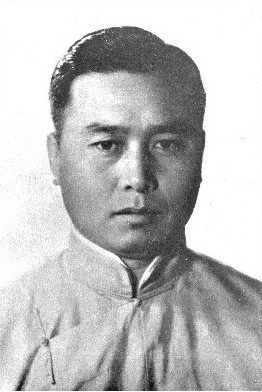
Tung Hu Ling was a Chinese and later American master of tai chi, known for teaching Yang style and Tung style, and an early leader in the spread of tai chi worldwide. Born in Renze, Xingtai, Hebei, China, his father Tung Ying-chieh was a top disciple of Yang Chengfu and famous for his fighting skills. Also highly skilled and creative himself, Tung Hu Ling taught in mainland China, Hong Kong, Macau, Southeast Asia, North America, and Europe. He then emigrated to Hawaii, founding a school in Honolulu, continued teaching workshops around the world, and carried on the Tung family legacy.
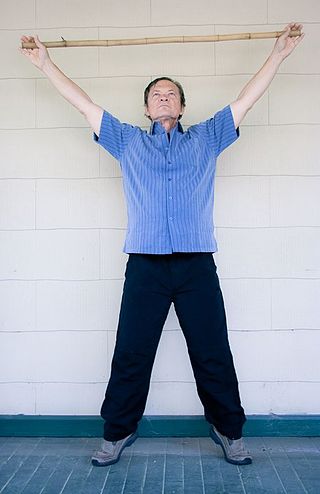
Chinese Wand (Jiangan) Exercise or Chinese Health Wand is an obscure ancient exercise system, related to the martial art Kung Fu. The "wand" in Chinese Wand Exercise is a 48-50" long dowel, 1" in diameter,, used as a fulcrum for balance, form and posture. "It’s the pyramid effect, with you as center." "Seventeen gentle bending, twisting and lunging movements flow in exact order, specially designed to get the blood circulating more efficiently throughout the body. These exercises are done in gradual, easy ‘Stages’ while using an original Chinese deep-breathing technique" and chi energy, and can be easy or more challenging as the individual chooses.

Joey Bond, is a Romanian-born author, composer, and teacher of Tai Chi. He had a nationally syndicated PBS series which aired on 134 stations, which includes worldwide distribution, from 1994–present, entitled Tai Chi Innerwave with Joey Bond, comprising 23 programs. Bond teaches Tai Chi Ch’uan and other martial art styles. His students have included golfer Maggie Will and musician Ben Taylor. Bond is, as well, a professional magician.
References
- ↑ Helms, Marisa (2012-05-08). "King of the Kettlebell". Star Tribune.